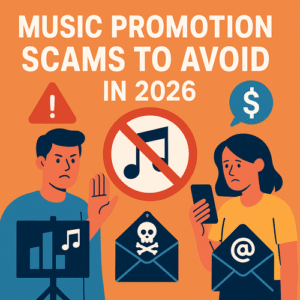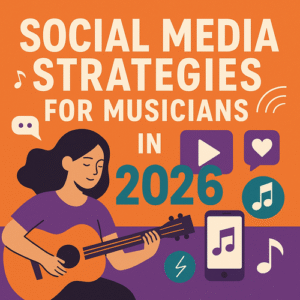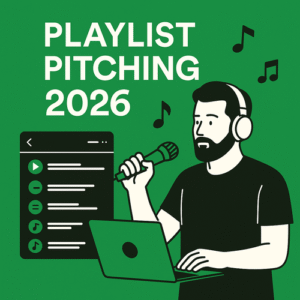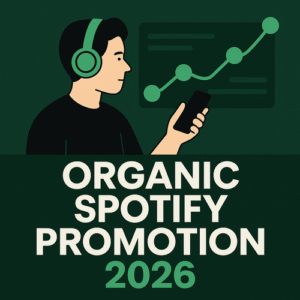Getting featured on Spotify’s Release Radar can change everything for an independent artist. It’s one of the most powerful algorithmic playlists on the platform, designed to show your new releases to people who already follow you or listen to similar music.
Unlike curated playlists, Release Radar isn’t managed by a person—it’s powered by Spotify’s algorithm. That means you can trigger it through smart strategy, consistent engagement, and organic growth.
If you’ve ever wondered how to land your music on Release Radar (and stay there week after week), this guide breaks down exactly what to do.
What Is Spotify Release Radar?
Release Radar is an automatically generated playlist that updates every Friday for each Spotify user. It features new songs from artists they follow and music similar to their listening habits.
In other words, when someone follows you on Spotify, your new release has a high chance of appearing in their personal Release Radar. It’s like a direct line from your studio to your fans’ playlists.
For independent artists, this is one of the most effective ways to build awareness, gain streams, and grow organically.
Why Release Radar Is So Powerful
Unlike other algorithmic playlists, Release Radar targets your existing audience first. That means your listeners are already warm leads—they’ve shown interest in your music before.
When these followers stream your new song right away, Spotify’s algorithm interprets that as a sign of engagement and pushes your track further into other users’ feeds.
This is why Release Radar can lead to:
- A big jump in first-week streams
- Better algorithmic placement on Discover Weekly
- Increased follower and save counts
- Stronger fan retention after release
For independent artists without a label, Release Radar is essentially free advertising directly to your fans.
Step 1: Make Sure You’re Listed as an Artist on Spotify for Artists
Before anything else, claim your profile on Spotify for Artists. This allows you to control your bio, profile picture, and most importantly—submit upcoming releases for playlist consideration.
Once your distributor delivers your track to Spotify, it should appear in your Spotify for Artists dashboard under “Upcoming Releases.” From there, you can pitch it for editorial consideration (more on that later).
Step 2: Submit Your Song Early (At Least 7 Days Before Release)
Timing is everything. Spotify’s system needs time to process your release and include it in algorithmic playlists like Release Radar.
If you submit your song less than 7 days before the release date, it likely won’t appear on your followers’ Release Radar.
For the best results:
- Distribute your song 2–3 weeks before release.
- Pitch your track in Spotify for Artists at least one full week in advance.
- Double-check that your distributor (e.g., DistroKid, TuneCore, CD Baby) has delivered the release correctly.
This preparation step alone can determine whether you make it into the playlist or not.
Step 3: Encourage Fans to Follow You on Spotify
Here’s the secret: Release Radar only includes your music for people who follow you.
That means the more followers you have, the more people will automatically see your song when it drops.
Use your social platforms to remind fans to hit “Follow” on your Spotify profile. For example:
- Add “Follow me on Spotify for new releases every month!” in your bio.
- Post story links on Instagram or TikTok leading directly to your profile.
- Mention Spotify follows in your YouTube video descriptions.
Even a few hundred loyal followers can create a strong algorithmic push once they engage with your music.
Step 4: Keep a Consistent Release Schedule
Spotify rewards consistency. Artists who release music regularly (every 4–8 weeks) tend to perform better in algorithmic playlists.
The logic is simple: regular uploads keep your listeners engaged, which strengthens your data and signals to Spotify that your profile is active.
If you go months without releasing anything, your profile’s momentum drops—and so does your Release Radar priority.
Plan ahead using a release calendar and stick to it.
Step 5: Optimize Your Metadata and Song Details
Spotify uses metadata to understand your song and match it to the right listeners. When uploading your release, make sure you:
- Use accurate genres and moods (don’t over-tag)
- Add clear artist credits (especially for collaborations)
- Include a professional cover image
- Keep your song title simple and searchable
Good metadata ensures that Spotify knows exactly where your music belongs—and who should hear it.
Step 6: Build Early Engagement
The first 48 hours after release are crucial. Spotify’s algorithm tracks how people interact with your song as soon as it drops.
Encourage your fans to:
- Stream the song multiple times
- Add it to their own playlists
- Save it to their library
- Share it with friends or post it on social media
The stronger your engagement early on, the higher your chance of being included not only in Release Radar but also Discover Weekly and Radio.
Boost Your Music with Daimoon.media
Daimoon.media is a leading music marketing agency based in Rotterdam, helping both emerging and established artists grow their presence on Spotify, YouTube, and SoundCloud. With a proven track record—over 10,000 artists served, 15 million YouTube views, and millions of playlist listeners—Daimoon.media delivers safe, organic, and fully tailored promotion campaigns for every genre.
Step 7: Promote Cross-Platform
Release Radar doesn’t exist in isolation. Use your other platforms to funnel traffic into Spotify during release week.
For example:
- Tease your new track on TikTok or Reels a few days before launch.
- Upload a YouTube Shorts video with the same hook.
- Send an email to your mailing list linking to the Spotify pre-save.
The goal is to drive attention from multiple directions so Spotify registers a surge of engagement once your song goes live.
Step 8: Use Pre-Saves to Build Momentum
A pre-save campaign allows fans to automatically add your upcoming release to their Spotify library when it drops.
Tools like Hypeddit, Feature.fm, and Show.co make it easy to set up pre-save links. The more pre-saves you collect, the better your launch-day performance will be—giving your song a strong signal for Release Radar inclusion.
Step 9: Collaborate with Other Artists
When you collaborate on a song, you gain access to each artist’s follower base. This means your release can appear in multiple Release Radars simultaneously.
For example, if two artists collaborate and both have 5,000 followers, the song could appear in 10,000 Release Radars in total.
Collaboration also boosts discovery and networking opportunities, multiplying your growth potential with every release.
Step 10: Focus on Long-Term Data
Spotify’s algorithm is data-driven. The more positive engagement you accumulate—followers, saves, playlist adds—the better your chances of future inclusion in algorithmic playlists.
Even if your first few releases don’t land on Release Radar, keep going. Every release improves your artist profile’s trust and discoverability.
Consistency + engagement = algorithmic success.
FAQ: Getting on Release Radar
1. What is Release Radar?
It’s a personalized Spotify playlist that updates every Friday with new songs from artists a user follows or listens to.
2. Can independent artists get on Release Radar?
Yes! Any artist with a verified Spotify for Artists account can appear in their followers’ Release Radars automatically.
3. How do I make sure my song gets included?
Submit it at least 7 days before release and encourage as many followers as possible.
4. Does playlist promotion help with Release Radar?
Yes—real playlist engagement improves your algorithmic performance and helps future releases appear faster.
5. Can I get removed from Release Radar?
Not if you follow Spotify’s rules. Avoid fake streams or bot services, and your account stays in good standing.




